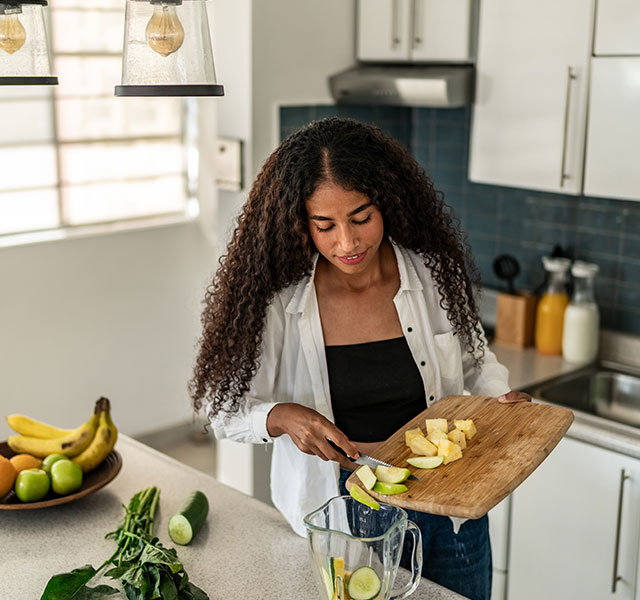We often hear health experts tell us to eat a “balanced diet.” But what does that really mean, and how can you tell if yours is balanced?
Henry Ford Health registered dietitian Ashlee Carnahan, MS, RDN, CLC, CPT, shares ways to check your eating habits and tips to make them healthier.
What Is a Balanced Diet?
Research suggests that the average adult doesn’t know what makes a balanced diet. A study of more than 9,000 people from the American Society for Nutrition found that nearly 85% overestimated how healthy their diet was.
“We receive a lot of conflicting information about nutrition from social media, food labels and the latest diet trends,” says Carnahan. “It’s easy to get confused and misled.”
Having a balanced diet isn’t optional—it’s an essential part of your health. “A healthy diet gives you nutrients you need for energy, immunity, mental focus and weight management,” says Carnahan. “It also helps you prevent chronic diseases like diabetes and heart disease.”
Wondering if your diet is as healthy as it could be? Your eating habits might need some tweaking if:
You frequently repeat meals
Everyone has their favorite foods and meals that have earned a regular spot in their kitchen. But if you’re reaching for the same foods every single day, consider changing it up.
For example, many people eat the same breakfast every morning out of habit. “Eating the same foods every day—even if they’re nutritious—could lead to a diet imbalance,” says Carnahan. “Eggs are high in protein and several vitamins and minerals, but they contain no fiber. Oatmeal is high in fiber, but doesn’t provide much protein. By alternating these two foods or having a half portion of each, you can achieve a balance you wouldn’t get from either food alone.”
Some celebrities are also touting the benefits of eating the same salad every day for lunch. “Salad is definitely healthy, but repeating the exact same vegetables might leave out key nutrients,” Carnahan explains. “Add other vegetables to your diet that you don’t typically find in salad, such as asparagus, Brussels sprouts or broccoli.”
You regularly eat packaged foods
Ultra-processed foods are quick and easy, and everyone reaches for a pack of crackers or protein bar now and then. But if your meals frequently come from boxes or bags, you might have an unbalanced diet.
“Eating processed foods as more than an occasional treat can lead to nutrient gaps,” says Carnahan. “Even processed foods that have vitamins added, such as bars or shakes, are often missing fiber and have added preservatives. Consuming food in its whole, natural state is the best way to absorb and get the nutrient benefits from that food.
If you frequently eat meals on the go, consider easy-to-grab whole foods instead of processed options. “Making a smoothie from fruits, vegetables and yogurt is a meal you can take and run,” says Carnahan. “Or cut up fruits and vegetables in advance and have them ready to go in small containers. Throw in some nuts or seeds for extra protein and minerals. These options ensure you get nutrients that processed foods don’t offer.”
Your plate lacks color
If your plate looks like a sad beige palette most of the time, you’re likely missing out on important nutrients. That’s why “eating the rainbow” is solid advice for a balanced diet.
“The foods we eat every day should contain a variety of bright colors, like green, orange, red, blue and purple,” says Carnahan. “If your meals are mostly white, tan and brown, you might be eating too many low-nutrient foods like white bread, fries and chicken nuggets.”
When you shop for groceries, focus on a colorful cartful of produce. “Each color in a food—like the orange in carrots or the blue in blueberries—had a unique nutrient profile,” Carnahan says. “Natural, colorful produce will also be a good source of fiber, which many people don’t get enough of.”
The Dietary Guidelines for Americans recommend two cups of fruit and three cups of vegetables every day. Making your meals more colorful helps you get closer to this goal.

Subscribe To Our E-Newsletter
“Striving to eat the rainbow is a great way to make your diet more balanced,” Carnahan says. “You’re focusing on nutrient-dense foods and eating fewer low-nutrient foods.”
See a Dietitian to Balance Your Diet
If all the diet advice out there is confusing, you’re not alone. That’s why many people find that they need a pro to get on the right track. Whether you need to change your diet for a health condition or just want to feel your best, a registered dietitian can help.
“A skilled dietitian can evaluate your eating habits and look for physical signs of a nutrient deficiency,” says Carnahan. “We may also work with your primary care provider to order blood tests if needed.”
From there, your dietitian can help you create an eating plan that fits your medical needs and personal taste. “A balanced diet isn’t restrictive or extreme, but contains a range of nutritious foods,” Carnahan says. “There’s room for all the foods you love, including occasional treats, when you find that balance—that’s the beauty of it.”
Reviewed by Ashlee Carnahan, a registered dietitian nutritionist who sees patients at Henry Ford Hospital.



